November 4, 2022, marked the mandatory compliance deadline with respect to the SEC’s overhauled Marketing Rule. It also marked the day that the SEC’s former Cash Solicitation Rule was put out to pasture after 43 years. It was a good run.
The former Cash Solicitation Rule may be gone, but it is not forgotten; many conceptual tenets were repackaged into the Marketing Rule. Many were not. However, the fundamental tenets that survived the transition to the Marketing Rule now bear only a slim resemblance to their former selves.
SEC-registered advisers who wish to continue availing themselves of third-party client referral sources must therefore familiarize themselves with the Marketing Rule’s attendant compliance obligations and connect the dots between the terminology of the former Cash Solicitation Rule and the Marketing Rule while at the same time unlearning many of the former Cash Solicitation Rule’s core components. This article will attempt such re-education.
Structure & Terminology
In order to wrap one’s head around the treatment of client solicitation and referral activities under the Marketing Rule, there is a foundational rewiring that must first occur. Namely, the replacement of the previously defined term “solicitor” with the newly (though not technically) defined term “promoter”, along with the distinguishing characteristics of testimonials and endorsements, and how such advertisements are regulated by the SEC.
PROMOTERS ARE THE NEW SOLICITORS: UPDATED TERMINOLOGY UNDER THE SEC’S NEW MARKETING RULE
The Marketing Rule’s Adopting Release introduces the term “promoter” into the regulatory lexicon as a quasi-replacement of what the SEC and the industry had both previously considered a “solicitor” (i.e., any person who, directly or indirectly, solicits any client for, or refers any client to, an investment adviser) :
While we traditionally referred to those who engaged in compensated solicitation activity under the current solicitation rule as “solicitors,” we use the term “promoter” in this release to refer to a person providing a testimonial or endorsement, whether compensated or uncompensated. We also use the term “provider” at times when discussing a person providing an uncompensated testimonial or endorsement.
Curiously, the term “promoter” is not used a single time in the actual Marketing Rule itself and is instead relegated to the Adopting Release. Regardless, it is important to first recognize that the term “solicitor” is no longer a defined term (since the definition appeared in the former Cash Solicitation Rule) and is effectively replaced – though undefined in the Marketing Rule – by the term “promoter”.
Also, to the extent that the term “provider” is used in the Adopting Release or subsequent guidance (though again, not the Marketing Rule itself), it is intended to refer to someone that provides a testimonial or endorsement for an investment adviser but is not compensated for such activity.
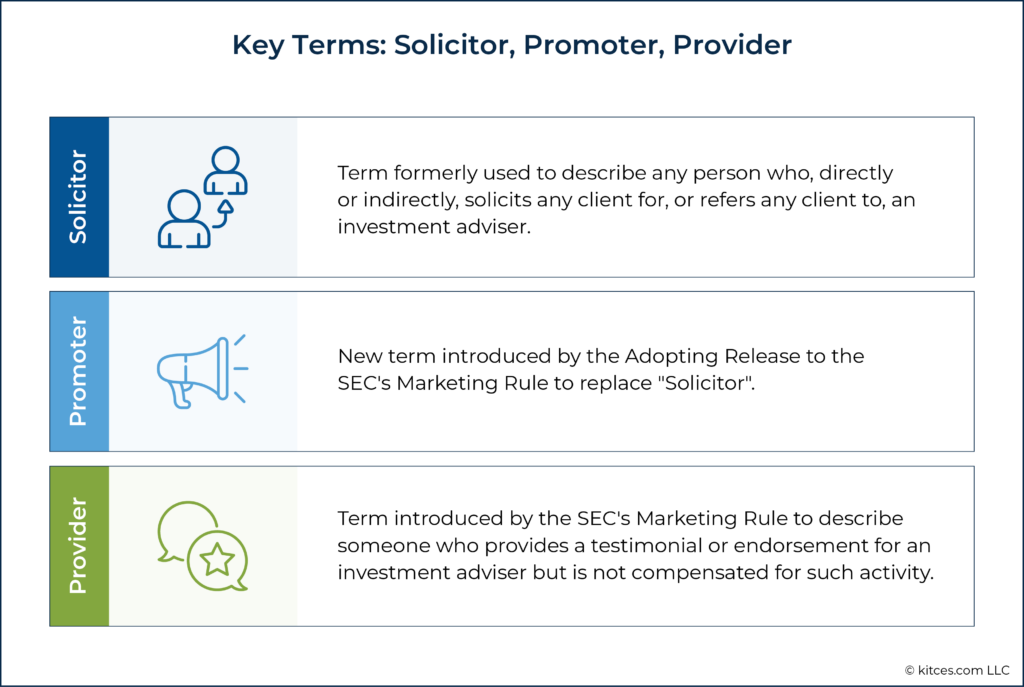
SOLICITING (PROMOTING) OR REFERRING: DISTINGUISHING BETWEEN TESTIMONIALS AND ENDORSEMENTS
The act of soliciting or referring a prospective client to an adviser is generally considered to be a “testimonial” or an “endorsement” – both of which are newly defined terms under the Marketing Rule.
According to the rule, a testimonial is a statement by an adviser’s current client or fund investor:
- About the client or investor’s experience with the investment adviser or its supervised persons;
- That directly or indirectly solicits any current or prospective client or investor to be a client of, or an investor in a private fund advised by, the investment adviser; or
- That refers any current or prospective client or investor to be a client of, or an investor in a private fund advised by, the investment adviser.
An endorsement is a statement by someone other than an adviser’s current client or fund investor that:
- Indicates approval, support, or recommendation of the investment adviser or its supervised persons or describes that person’s experience with the investment adviser or its supervised persons;
- Directly or indirectly solicits any current or prospective client or investor to be a client of, or an investor in a private fund advised by, the investment adviser; or
- Refers any current or prospective client or investor to be a client of, or an investor in a private fund advised by, the investment adviser.
Thus, the solicitation or referral of prospective clients by an adviser’s existing client is generally considered to be a testimonial, and the solicitation or referral of prospective clients by anyone else is considered to be an endorsement. Testimonials also include statements by an adviser’s existing client about the existing client’s experience with the adviser, even if not explicitly constituting a solicitation or referral of the adviser. Endorsements also include statements by non-clients that indicate approval, support, or recommendation of the adviser, even if not explicitly constituting a solicitation or referral of the adviser.
Traditional third-party-solicitor or referral relationships (e.g., pursuant to which an adviser shares revenue or otherwise compensates another professional for referring a prospective client to the adviser) therefore remain squarely within the definition of an endorsement.
In addition, the “approval, support, or recommendation” language within the definition of endorsement is the reason that many so-called “operators” under the Adopting Release (i.e., lead-generation firms, adviser referral networks, and client-to-adviser matchmaking websites) are “likely” to meet the definition of an endorsement and therefore will subject the advisers utilizing such operators to the Marketing Rule’s attendant compliance obligations:
An operator may tout the advisers included in its network, and/or guarantee that the advisers meet the network’s eligibility criteria. In addition, because operators typically offer to “match” an investor with one or more advisers compensating it to participate in the service, operators typically engage in solicitation or referral activities.
Setting aside the potential need for an operator to register as an investment adviser with either the SEC or one or more state securities authorities (which is a whole other can of worms), an adviser that retains an operator to provide client lead generation, matching, or referrals will need to recognize that such engagement will likely be deemed an endorsement and will need to comply with the Marketing Rule accordingly.
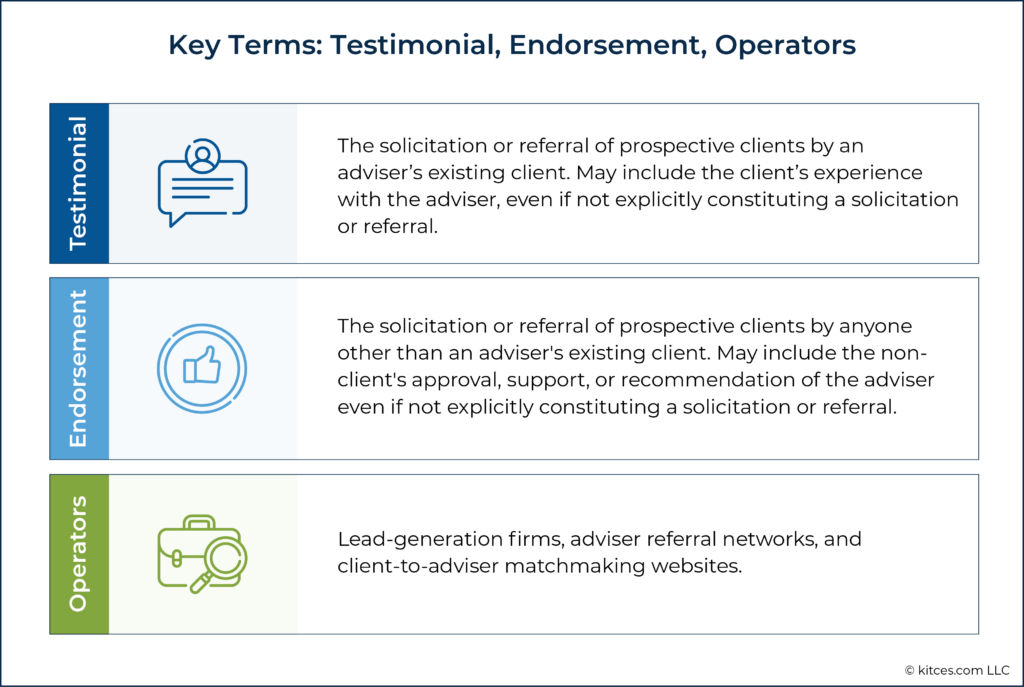
WHEN A TESTIMONIAL OR ENDORSEMENT IS CONSIDERED AN ADVERTISEMENT
The act of soliciting or referring a prospective client to an adviser for compensation is now generally considered to be an “advertisement” of the adviser. The term “advertisement” under the former Advertising Rule (the predecessor to the Marketing Rule) did not even remotely contemplate prospective client solicitation or referral activity and instead was limited to:
[A]ny notice, circular, letter or other written communication addressed to more than one person, or any notice or other announcement in any publication or by radio or television, which offers (1) any analysis, report, or publication concerning securities, or which is to be used in making any determination as to when to buy or sell any security, or which security to buy or sell, or (2) any graph, chart, formula, or other device to be used in making any determination as to when to buy or sell any security, or which security to buy or sell, or (3) any other investment advisory service with regard to securities.
This comparatively narrow definition of advertisement did not encompass prospective client solicitation or referral activity ostensibly because such activity was separately addressed in its own rule – the former Cash Solicitation Rule. With the former Cash Solicitation Rule on the chopping block, the SEC needed to shoehorn prospective client solicitation and referral activity somewhere else in the rules promulgated under the Federal Investment Advisers Act of 1940 (the “Advisers Act”). The Marketing Rule apparently fits the bill.
In addition to the more traditional forms of advertising captured in the first prong of the Marketing Rule’s definition of “advertisement”, the second prong now includes “Any endorsement or testimonial for which an investment adviser provides compensation, directly or indirectly…”. While uncompensated testimonials and endorsements may still be considered an advertisement under the first prong (as the promoter may effectively serve as the dissemination means of an adviser’s advertisement), this article instead focuses on the more typical arrangement in which promoters are compensated for their prospective client solicitation or referral activities.

ADVERTISEMENTS AND THE MARKETING RULE: REGULATION IMPLICATIONS FOR ADVISERS AND PROMOTERS
The characterization of a communication or a statement as an advertisement under the Marketing Rule has significant implications. For a more exhaustive analysis of the elements of the Marketing Rule that do not specifically implicate solicitation or referral activity, you are encouraged to review 2 previous articles entitled Advertising With Testimonials And Endorsements Under The New SEC Marketing Rule and Performance Advertising Guidelines For Investment Advisers Under the SEC’s New Marketing Rule.
The TLDR version of both articles can be distilled by quoting Samuel L. Jackson from the original Jurassic Park: “Hold on to your butts.” There’s a lot to unpack in the Marketing Rule overall, and this article’s treatment of the solicitation and referral aspects is but a single crumb of a much larger loaf.
To summarize the trail of breadcrumbs thus far before diving into the specific compliance obligations:
- A solicitor is now referred to as a promoter;
- A promoter that solicits or refers a client to an adviser will generally be considered to be making an endorsement or a testimonial;
- An endorsement or testimonial for which compensation is paid will generally be considered an advertisement of the adviser;
- Advertisements are governed by the Marketing Rule; and
- The Marketing Rule imposes various prohibitions and compliance obligations with respect to advertisements generally, and with respect to testimonials and endorsements specifically.
Compliance Obligations
For an example of how advisers would engage in a relationship with a promoter under the new Marketing Rule, consider the following compliance journey of a hypothetical adviser and a hypothetical promoter that are about to establish a compensated client-referral relationship.
Backwoods Advisors (“Backwoods”) is an SEC-registered investment adviser that wants to grow its base of clients. Highfalutin Accounting Services (“Highfalutin”) is an independent and unaffiliated accounting firm that happens to occupy the office next to Backwoods and wants to introduce its accounting clients to Backwoods for the provision of investment advisory services. Both Backwoods and Highfalutin agree that Highfalutin should be compensated for its accounting clients that become investment advisory clients of Backwoods. We’ll assume that Highfalutin is not a client of Backwoods, and thus the referral of clients by Highfalutin to Backwoods is an endorsement and not a testimonial.
Where do Backwoods and Highfalutin start?
ELIGIBILITY
Setting aside the need for Highfalutin Accounting Services to determine whether it needs to independently register as an investment adviser in order to receive compensation for client referrals (a crucial determination that is beyond the scope of this article), Backwoods Advisors should first endeavor to determine whether Highfalutin is even eligible to receive compensation for client referrals, or instead if Highfalutin is an “ineligible person”, as the Marketing Rule generally prohibits an adviser for compensating an ineligible person for a testimonial or an endorsement.
According to the Marketing Rule, an ineligible person is someone who is subject to a disqualifying SEC action or is subject to any disqualifying event. A disqualifying SEC action means an SEC opinion or order barring, suspending, or prohibiting the person from acting in any capacity under Federal securities laws. The definition of a disqualifying event is a bit more complicated and subject to applicable carve-outs, but generally includes any of the following events that occurred within 10 years prior to the person disseminating an endorsement or testimonial:
- Felony or misdemeanor convictions under paragraph 2(A) through (D) of section 203(e) of the Advisers Act (generally involving the taking of a false oath, the making of a false report, bribery, perjury, burglary, larceny, theft, robbery, extortion, forgery, counterfeiting, fraudulent concealment, embezzlement, fraudulent conversion, or misappropriation of funds or securities);
- A conviction of engaging in any of the conduct specified in paragraphs (1), (5), or (6) of section 203(e) of the Advisers Act (making a false or misleading statement with respect to any material fact in any SEC application, report or proceeding, or omitting to state in any such application, report or proceeding any material fact which is required to be stated therein, willful violation of certain Federal securities laws, and willful aiding, abetting, counseling, commanding, inducing, or procuring the violation by any other person of certain federal securities laws);
- A final order by any entity described in paragraph (9) of section 203(e) of the Advisers Act (generally state regulatory authorities), or by the U.S. Commodity Futures Trading Commission or a self-regulatory organization, of the type described in paragraph (9) of section 203(e) of the Advisers Act;
- The entry of an order, judgment, or decree described in paragraph (4) of section 203(e) of the Advisers Act (generally prohibiting someone from acting as a regulated person like an investment adviser, broker-dealer, etc.), and still in effect; and
- An SEC cease-and-desist order from committing or causing a violation or future violation of any scienter-based anti-fraud provision of Federal securities laws or section 5 of the Securities Act (broad anti-fraud-based provisions that cover intentional, willful acts).
If Highfalutin is the subject of any of the aforementioned events and not otherwise carved out, Backwoods is statutorily prohibited from compensating Highfalutin for client referrals unless such compensation is limited to $1,000 or less (or the equivalent value in non-cash compensation) during the preceding 12 months. The SEC considers this amount to be de minimis.
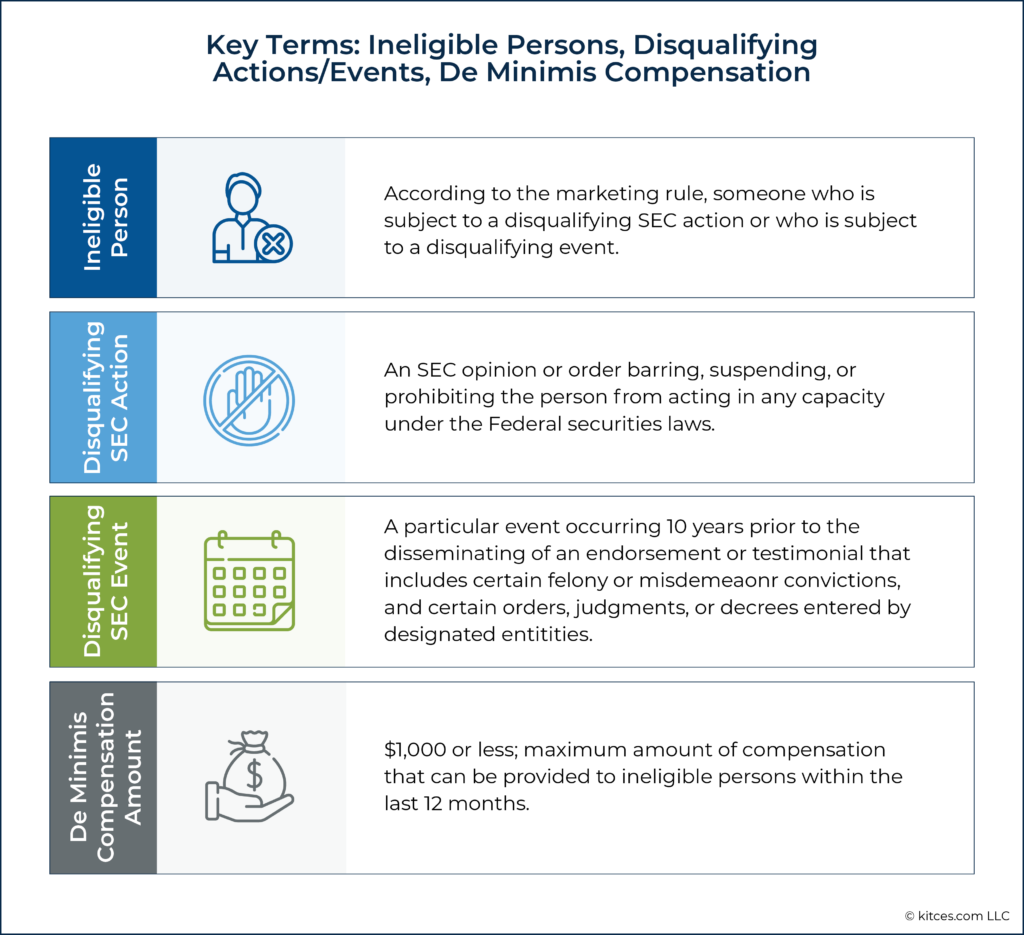
In other words, Backwoods is permitted to compensate Highfalutin for client referrals in an amount of up to $1,000 during the preceding 12 months without bumping up against the disqualifying SEC action or disqualifying event triggers that would otherwise cause Highfalutin to be an ineligible person.
Does this mean that Backwoods has to go to the ends of the earth to determine if Highfalutin is an ineligible person? In short, no. The Marketing Rule holds advisers to the standard of actual knowledge of the promoter’s ineligibility or knowledge of the promoter’s ineligibility that the adviser should have known in the exercise of reasonable care. The SEC does not prescribe exactly what it expects advisers to do in order to satisfy the reasonable care standard, but the Adopting Release does contain a few helpful clues:
The final marketing rule will not require an adviser to monitor the eligibility of compensated promoters on a continuous basis, as one commenter suggested. The frequency with which an adviser must monitor eligibility and the steps an adviser must take in making this assessment will vary depending on what constitutes the exercise of reasonable care in a particular set of facts and circumstances. […]
Factual inquiry by means of questionnaires or certifications, perhaps accompanied by contractual representations, covenants and undertakings, may be sufficient in other circumstances, particularly if there is no information or other indicators suggesting bad actor involvement.
If Backwoods previously witnessed an FBI raid of Highfalutin’s offices a few weeks prior, it would be reasonable for Backwoods to further research and inquire as to Highfalutin’s promoter eligibility. If it has no reason to suspect that Highfalutin is a “bad actor,” it would still be appropriate to have Highfalutin complete an eligibility questionnaire and/or make eligibility representations in the agreement to be signed between Backwoods and Highfalutin (more on such agreement below). The eligibility questionnaire could ask about the statutory disqualifications enumerated above, both at the time of first establishing the relationship with Highfalutin and on a periodic recurring basis thereafter.
WRITTEN AGREEMENT
Once Backwoods is satisfied that Highfalutin is eligible to be compensated for client referrals, the next step is to execute a written agreement between the parties that describes the scope of the agreed-upon activities and the terms of compensation for those activities. The only exception to the written agreement requirement is if Backwoods is to pay Highfalutin no more than de minimis compensation (i.e., $1,000 during the preceding 12 months) in consideration for client referrals.
Let’s assume that Highfalutin has negotiated to receive 30% of the gross investment advisory fees received by Backwoods from clients referred by Highfalutin for 5 years. Let’s also assume that this compensation arrangement constitutes more than de minimis compensation. Because more than de minimis compensation is to be paid, the Backwoods/Highfalutin agreement should ideally be signed before the first client referral is made. The agreement, at a minimum, should include the activities Highfalutin is to perform for Backwoods as well as the compensation Backwoods is to pay Highfalutin, but it would be prudent to also include provisions that account for the following:
- Highfalutin’s compliance with the Advisers Act;
- Highfalutin’s continuing representation and warranty that it is not an ineligible person;
- Highfalutin’s covenant to notify Backwoods if it becomes an ineligible person;
- Highfalutin’s registration as an investment adviser, investment adviser representative, or exemption from such registration requirements;
- Highfalutin’s use of only Backwoods-approved marketing material (if any);
- Which party assumes the responsibility for making the disclosures required by the Marketing Rule (more on such disclosures below);
- The fact that Backwoods is not obligated to accept any clients referred by Highfalutin;
- Appropriate indemnification provisions;
- The terms and conditions for termination of the agreement; and
- Other standard/boilerplate legal provisions.
Drafting legal agreements – including an agreement between an adviser and a promoter – falls squarely within the practice of law; as such, Backwoods should ideally utilize either internal or external counsel to add the needed structure and elaboration to the elements above. Backwoods should be sure to save the signed/dated written agreement in its files, as it is a required record under the SEC’s recordkeeping rule.
REQUIRED DISCLOSURES
When Highfalutin is ready to refer the first of its accounting clients to Backwoods (let’s call her Charlene), either Highfalutin or Backwoods must make 5 specific disclosures to Charlene at the time the referral is made:
- Highfalutin is not a client of Backwoods;
- Cash compensation was provided by Backwoods for Highfalutin’s endorsement;
- A brief statement of any material conflicts of interest on the part of Highfalutin resulting from Backwoods’ relationship with Highfalutin;
- The material terms of the compensation arrangement (i.e., 30% revenue sharing for 5 years); and
- A description of any material conflicts of interest on the part of Highfalutin resulting from Backwoods’ relationship with Highfalutin and/or any compensation arrangement.
For example, if Highfalutin refers Charlene to Backwoods via email, then the body of the email could include disclosures 1 through 3, while disclosures 4 through 5 could be made via hyperlink to a separate website or document. Backwoods must either make all 5 disclosures to Charlene itself or must “reasonably believe” that Highfalutin makes all 5 disclosures to Charlene. If Highfalutin is to make the disclosures to Charlene, Backwoods can achieve such reasonable belief by providing the disclosures to Highfalutin and subsequently seeking to confirm that they have indeed been provided to Charlene.
The first 3 disclosures above must be made “clearly and prominently” to Charlene, which means that such disclosures “must be at least as prominent as” the endorsement. If Highfalutin refers Charlene to Backwoods in writing (e.g., by sending Charlene an email that recommends Backwoods for investment advisory services), such clear and prominent disclosures must be included within the same communication and be at least as prominent as the recommendation of Backwoods itself. As the SEC itself stated in the adopting release, “such disclosures should appear close to the associated statement such that the statement and disclosures are read at the same time, rather than referring the reader somewhere else to obtain the disclosures.”
In the event that Highfalutin verbally refers Charlene to Backwoods, all 5 required disclosures must be provided at the same time as the actual oral communication in which Highfalutin refers Charlene to Backwoods (even if the last 2 disclosures above need not be made clearly or prominently). All such disclosures may be provided verbally or in writing.
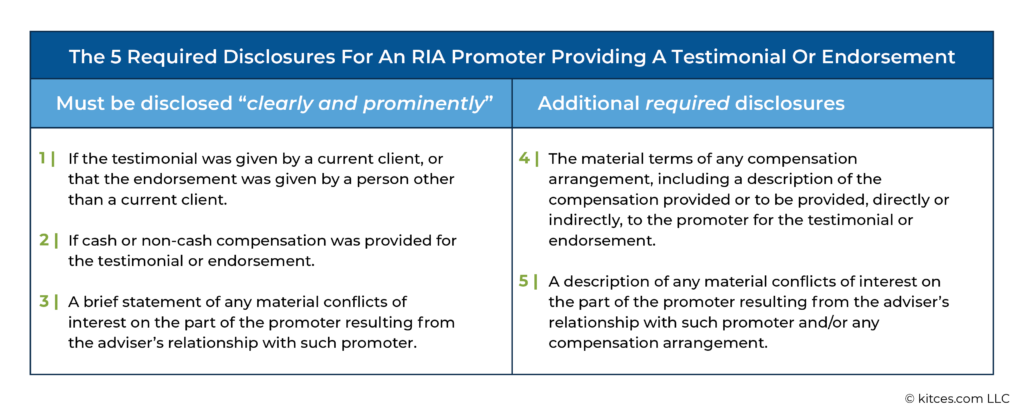
Regardless of whether the disclosures are provided by Backwoods or Highfalutin, or whether they are provided verbally or in writing, Backwoods must keep a record of what disclosures were made to Charlene and when. This written record can be satisfied by the actual written disclosures (if made in writing) or an endorsement-disclosure log of sorts (if made verbally). Backwoods need not maintain an actual audio recording of verbally delivered disclosures.
If Highfalutin’s verbal referral of Charlene to Backwoods is to be accompanied by written disclosures instead of verbal disclosures, the person delivering such written disclosures must alert Charlene to the importance of the written disclosures (particularly with respect to the disclosures that must be provided clearly and prominently).
For better or worse, neither Backwoods nor Highfalutin will be able to avoid disclosing the actual compensation arrangement between them to Charlene. In other words, Charlene can’t simply be informed that the parties will share fees, but must instead be apprised of the specific fee-sharing percentage (30%) and duration (5 years).
Similarly, if a material conflict of interest exists between Backwoods and Highfalutin, neither party will be able to avoid disclosing such conflict to Charlene. For example, disclosure would likely be warranted if Highfalutin is indebted to Backwoods, if family relatives of Highfalutin’s owners are employed by Backwoods, or if Backwoods is the landlord of the office that Highfalutin occupies and Backwoods is charging Highfalutin below-market rent (ostensibly with the expectation that Highfalutin will refer prospective advisory clients in exchange).
OVERSIGHT AND COMPLIANCE
In addition to entering into a written agreement with Highfalutin and ensuring appropriate disclosures are made to Charlene as described above, Backwoods must also have a reasonable basis for believing that Highfalutin’s endorsement complies with the Marketing Rule overall.
In typical SEC fashion, the Adopting Release does not specify what would constitute a reasonable basis for Backwoods to believe that Highfalutin’s endorsement complies with the Marketing Rule overall. Instead, what would constitute a reasonable basis depends on the facts and circumstances. However, there are a few helpful clues sprinkled throughout the Adopting Release that can point Backwoods in the right direction:
…in the context of solicitation or referral activity, we believe that […] a reasonable basis could involve periodically making inquiries of a sample of investors solicited or referred by the promoter in order to assess whether that promoter’s statements comply with the rule. An adviser could implement policies and procedures to form a reasonable basis for believing the testimonial or endorsement complies with the rule. An adviser also could include terms in its written agreement with the promoter to help form such a reasonable belief. Such agreements could provide mechanisms, for example, to enable advisers to pre-review testimonials or endorsements, or otherwise impose limitations on the content of those statements.
In other words, Backwoods could satisfy the endorsement oversight and compliance requirements with respect to Highfalutin by:
- Asking Charlene what Highfalutin conveyed to her and when as part of her referral to Backwoods (e.g., asking Charlene to describe what written or verbal statements and disclosures were made to her by Highfalutin, or having her provide a copy of such statements and disclosures to Backwoods if made in writing);
- Adopting policies and procedures that memorialize its oversight efforts with respect to Highfalutin (and any future promoters);
- Providing Highfalutin with pre-approved marketing materials, disclosures, and other materials to use in connection with prospective client referrals; and
- Including appropriate representations, warranties, and covenants to be made by Highfalutin in the written agreement between the parties.
FORM ADV DISCLOSURE
In connection with establishing the promoter relationship with Highfalutin, Backwoods should ensure that it discloses such relationship in its Form ADV Part 1 and Form ADV Part 2A. More specifically, Backwoods should make the following updates:
- Revise Form ADV Part 1, Item 5.B.(6) (“Approximately how many firms or other persons solicit advisory clients on your behalf?”) to reflect “1” (assuming Highfalutin is the sole promoter for Backwoods);
- Revise Form ADV Part 1, Item 8.H.(1) (“Do you or any related person, directly or indirectly, compensate any person that is not an employee for client referrals?”) to reflect “Yes”. If Backwoods acts as a promoter in the future for another firm, it should update Form ADV Part 1, Item 8.H.(I) (“Do you or any related person, including any employee, directly or indirectly, receive compensation from any person (other than you or any related person) for client referrals?”) to “Yes.”
- Revise Form ADV Part 2A, Item 14 (“Client Referrals and Other Compensation”) to disclose that it compensates Highfalutin for prospective client referrals. This question simply asks for the adviser to “describe the arrangement and the compensation,” but the Form ADV Part 2A, Item 14 description need not necessarily go into the same level of detail as the disclosures to be made directly to Charlene.
Whether simply reviewing existing promoter relationships through the lens of the new Marketing Rule or embarking on a new promoter relationship for the first time, expect SEC examiners to take a close look at firms’ practices in either regard; a September 2022 Risk Alert drives this point home and puts the advisory industry on notice.
If there’s any compliance silver lining, it’s that the new Marketing Rule does not require promoters to deliver the adviser’s Form ADV Part 2 brochure, does not require a separate promoter’s disclosure document, and does not require a signed and dated acknowledgment of receipt from the referred client (all of which were required under the former Cash Solicitation Rule).
Yet for those advisers wishing to avail themselves of the services of a solici… I mean… promoter (old habits die hard), there is still plenty of compliance meat on the Marketing Rule bone.
* * * * *
This article originally appeared in Michael Kitces’ Nerd’s Eye View on February 1, 2023.

You must be logged in to post a comment.